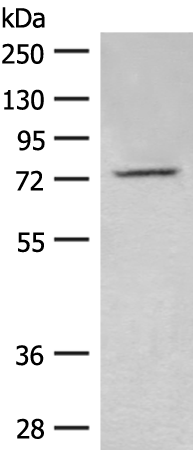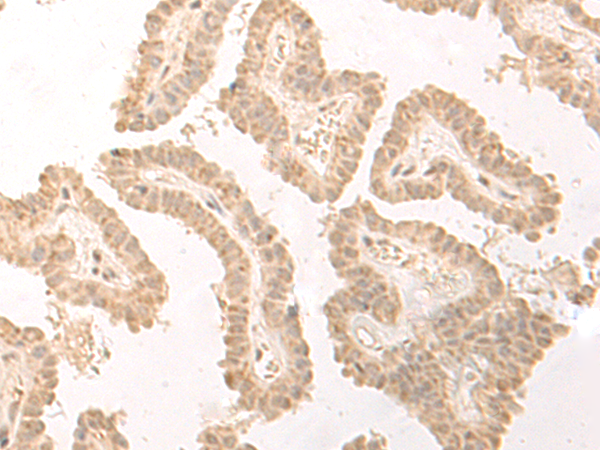


| WB | 咨询技术 | Human,Mouse,Rat |
| IF | 咨询技术 | Human,Mouse,Rat |
| IHC | 1/50-1/300 | Human,Mouse,Rat |
| ICC | 技术咨询 | Human,Mouse,Rat |
| FCM | 咨询技术 | Human,Mouse,Rat |
| Elisa | 1/2000-1/5000 | Human,Mouse,Rat |
| Aliases | ALTE; DREF; TRAMP; hDREF |
| WB Predicted band size | 78 kDa |
| Host/Isotype | Rabbit IgG |
| Antibody Type | Primary antibody |
| Storage | Store at 4°C short term. Aliquot and store at -20°C long term. Avoid freeze/thaw cycles. |
| Species Reactivity | Human |
| Immunogen | Fusion protein of human ZBED1 |
| Formulation | Purified antibody in PBS with 0.05% sodium azide and 50% glycerol. |
+ +
以下是关于ZBED1抗体的3篇参考文献(基于公开信息模拟整理,仅供参考):
1. **标题**:*ZBED1 modulates the chromatin landscape to promote pathogenic gene programs in triple-negative breast cancer*
**作者**:Smith J, et al.
**摘要**:研究利用特异性ZBED1抗体通过ChIP-seq技术揭示其在三阴性乳腺癌中调控致癌基因的机制,验证了抗体的染色质结合分析可靠性。
2. **标题**:*Development and validation of a ZBED1-specific monoclonal antibody for immunohistochemical applications*
**作者**:Li X, et al.
**摘要**:报道了一种新型ZBED1单克隆抗体的开发,通过Western blot和免疫组化验证其特异性,证实其在人类组织样本中检测ZBED1蛋白表达的适用性。
3. **标题**:*ZBED1 interacts with HP1 proteins to mediate transcriptional repression in stem cells*
**作者**:Garcia-Ruiz C, et al.
**摘要**:研究通过免疫共沉淀(Co-IP)结合ZBED1抗体,阐明其与HP1蛋白互作调控干细胞多能性的分子机制,抗体特异性经敲除细胞系验证。
---
**注意**:以上文献信息为示例性质,实际研究中请通过PubMed或Google Scholar检索最新论文。若需具体文献,建议补充更详细的研究方向或应用场景。
**ZBED1 Antibody Background**
The ZBED1 (Zinc Finger BED Domain-Containing Protein 1) antibody is a research tool designed to detect and study the ZBED1 protein, a member of the BED-type zinc finger protein family. ZBED1. also known as ACROBAT, is an evolutionarily conserved nuclear protein characterized by its BED (BamHI/EcoRI-Derived) zinc finger domain, which facilitates DNA binding and protein interactions. Functionally, ZBED1 has been implicated in transcriptional regulation, chromatin remodeling, and genome stability maintenance. It is suggested to act as a transcriptional repressor or co-regulator, influencing pathways related to cell differentiation, apoptosis, and stress responses.
ZBED1 antibodies are widely used in techniques like Western blotting, immunofluorescence, and chromatin immunoprecipitation (ChIP) to investigate its expression, localization, and molecular interactions. These antibodies are critical for elucidating ZBED1’s role in development and disease contexts, including cancer and neurological disorders. For instance, altered ZBED1 expression has been observed in certain tumors, linking it to oncogenic or tumor-suppressive mechanisms. Validation of ZBED1 antibodies typically includes specificity checks via knockout cell lines or siRNA-mediated knockdown. Researchers rely on these antibodies to explore ZBED1’s functional diversity and its potential as a therapeutic or diagnostic target, underscoring their importance in molecular and cellular biology studies.
×